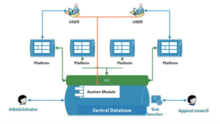Prozorro



ProZorro (Ukrainian: Прозоро – transparent, clear) is a public e-procurement system and a symbol of dramatic reform of government procurement in Ukraine. This system was developed by volunteers, NGOs, business community and state bodies of Ukraine to provide a novel solution to procurement inefficiencies. In December 2015 ProZorro system (together with relevant intellectual property rights) “was transferred to the people of Ukraine”, represented by the state of Ukraine.
Principles
Corporate philosophy of ProZorro is based on three key principles:
- Hybrid electronic system based on an open-source model. As opposed to the single and multi-platform systems, ProZorro’s hybrid model allows collaboration between the central database and infinite number of commercial marketplaces that provide front-end access. Such hybrid model enables efficient transmission of information from central databases to marketplaces responsible for attracting and serving clients. Marketplaces compete with each other which motivates them to provide best service in order to attract both contracting entities and suppliers. The code was initially developed by an international NGO Transparency International and is available via Apache 2.0 license.
- “Everyone can see everything” – is the official motto of ProZorro. After a tender procedure is complete absolutely all data is disclosed, including the list of all participants, their bids, decisions of the tender committee and all qualification documents, etc. This information is publicly accessible through ProZorro’s online analytics module.
- Golden triangle of partnership – a unique form of collaboration between business, state and civil society where functions are split between different stakeholders to ensure independence and mutual control. Such partnership aims at promoting change, while maintaining high level of trust between principal stakeholders throughout the course of this reform.*
Implementation
The Law “On public procurement” (2015) implemented the following reforms to the public procurement process:
- It introduced mandatory electronic public procurement procedures. This transition to The Law is accomplished through two phases. Beginning with Phase 1 (starting April 1, 2016), electronic public procurement is mandatory for central executive bodies and those offices carrying out monopolist activities. During Phase 2 (starting August 1, 2016), public e-procurement will become mandatory for all procuring entities.
- It introduced electronic auction which implies automatic evaluation of tender propositions.
- New terminology: authorized electronic market place, electronic procurement system, centralized procurement organization, system of cloud assessment.
- It reduced the number of procurement procedures from five (5) to three (3). Those remaining include open procedure, competitive dialogue, and negotiated procedure
- It changed existing terminology. For instance, instead of “state procurement,” the law uses “public procurement.” Other affected terms include “competition,” “competitive tendering documentation,” “competitive tendering proposal,” and “competitive tendering committee.” These are now substituted with “tender,” “tender documentation,” “tender proposal,” and “tender committee,” respectively.
Benefits of ProZorro system
- Provides instruments to eliminate and prevent corruption
- Ensures transparency of the entire tendering process
- Enables objective evaluation of tender proposals
- Transfers all tender documents to an electronic format
- Gives tools for comprehensive analysis of all stages of public procurement
- Allows for active participation of NGOs and other stakeholders
- Incorporates private electronic marketplaces that provide front-end access to central database of all data and transactions
World recognition
ProZorro was awarded the World Procurement Awards 2016 Public Sector Award in May 2016 for creating and implementing an e-procurement system with a unique architecture and philosophy. ProZorro development is a result of collaboration between Ukrainian government, business sector, and civil society. Transparency International Ukraine was the original administrator of ProZorro central database during pilot stage of the projects, afterwards all ownership rights were transferred to the state enterprise designated by Ministry of Economic Development and Trade of Ukraine.